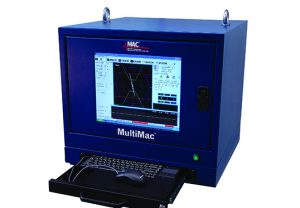FERRITIC INCLUSIONS IN NON-FERRITIC
TUBE, BAR AND WIRE
Inclusions are small particles or linear ferrite residuals that are usually considered to be undesirable. They may be spherical or elongated. They may originate from two major sources.
The first comes from the material melt, which can contain residual impurities. The second may originate during manufacturing and processing.
In addition, ferrous metal particles such as filings from finning tools can be detrimental to the finished configuration but they can be particularly small and difficult to find.
- Metallic inclusions can create problems when they occur in too high of a concentration.
- Some situations that could be caused by metallic inclusions in tube, bar and wire include pinholes, flange cracks, surface streaks, wire breakage, increased tool wear and tear, increased porosity, potential leaks, poor machinability and cosmetic surface defects.
- Tramp Metal inclusions can be small and may be difficult to find using standard Eddy Current test coils. An example is ferrous particles in austenitic stainless which can seriously affect the final product quality (stainless tube fitting for example).

Finned Copper Tube with Transitional (land) Zone
MAC Solutions:
- With a Flux Leakage Magnetic Inclusion Detector (MID), consisting of MultiMac® electronics with a special coil sensor to provide a DC field, very small ferrous inclusions in nonferrous tubes can be detected.
- MAC’s Production Comparator PC-VI with null test coils can detect small ferromagnetic inclusions and stringers in non-magnetic stainless steel rods and bars, and can also inspect most austenitic grade products. These include rounds, hexes and custom shapes. These linear inclusions can be detected at any depth in the solid bar product.

Stainless Bar with Ferromagnetic Inclusion
MULTIMAC®

- Rapid sorting of ferromagnetic parts with non-destructive testing (NDT).
- Offers choice of Polar (Vector) or Lissajou screen displays.
- Inspect tubes
orbars at
production line
speeds. - Choose any one
of 10 pre-set
frequencies from 10 Hz to 150 Hz. - Optional 8-channel multi-frequency software is available.
- System can be set up and monitored on site or used via computer at a remote location.
- Monitor presentation provides simultaneous display of the “standard” piece and test piece waveforms for easy comparison.
PRODUCTION COMPARATOR
Detects Variations in Alloy, Heat Treatment or Case Depth
- Rapid sorting of ferromagnetic parts with non-destructive testing (NDT).
- Offers choice of Polar (Vector) or Lissajou screen displays.
- Inspect tubes or bars at production line speeds.
- Choose any one of 10 pre-set frequencies from 10 Hz to 150 Hz.
- Optional 8-channel multi-frequency software is available.
- System can be set up and monitored on site or used via computer at a remote location.
- Monitor presentation provides simultaneous display of the “standard” piece and test piece waveforms for easy comparison.
EDDY CURRENT TECHNOLOGY IN NDT
MAC’s® Eddy Current Testing (ECT) systems incorporate computer-based test instruments and test coils that use two ECT coil technologies: encircling and sector coils, and spinning or rotary probe coils.
- Encircling and sector Eddy Current coil tests perform in this manner:
- The product is passed through or adjacent to an electrical test coil, which
has been excited by an alternating current. - This induces a flow of eddy currents around the test material or in the
case of a sector coil, in the area under the coil. - Short, intermittent anomalies or flaws cause a variation in the eddy
current pattern, which the instrument detects.

